#AI content identification
Explore tagged Tumblr posts
Text
Google's Gemini AI has introduced groundbreaking features that are set to revolutionize the way we search, communicate, and create content. 🌐📲 🔹 1 Million Words Processing: Handle massive documents effortlessly. 📜 🔹 Faster Responses: Real-time problem-solving and virtual assistance. ⚡💬 🔹 Circle to Search: Instantly find information by circling anything on your screen. 🔎📱 🔹 AI-Powered Video Creation: High-quality videos with ai magic #GeminiAI #GoogleAI #SmartTechnology #ArtificialInte
#advanced AI processing#AI content identification#AI content management#AI content verification#AI enhancements#AI for content creators#AI in Google Search#AI integration in technology#AI transformation#AI watermarking#AI-based scam prevention#AI-driven communication#AI-powered content#AI-powered video creation#automatic email drafts#Circle to Search#content authenticity#enhanced AI model#enhancing digital experiences.#fast and accurate responses#faster response AI#fraud prevention through AI#Future of AI#future of smart technology#future YouTube AI integration#future-ready AI#Gemini 1.5 Flash#Gemini 1.5 Pro#Gemini AI#Gemini AI for Google Photos
1 note
·
View note
Text
Annoyances
Whenever I see a "if you like AI, pls die" post, a part of me wants to take a big, gigantic breath and blurt out the following, Wall of Text style:
Narrow AI is vital to several scientific fields and refers to algorithms that are geared towards the collection, classification and proper identification of datum. It doesn't steal, it doesn't crib from anyone else, but it certainly helps with overlaying false colours on CAT scans and MRI results, for example.
Narrow AI is in your spreadsheet documents. If a spreadsheet is based on a few formulae to keep track of your budget, some measure of AI is involved.
Narrow AI is your average spell-checker's brain, as well. Not Google's - Google Docs just outsources Gemini for some truly godawful proofreading - but your average offline, dumb-as-bricks spell checker qualifies as Narrow AI.
Narrow AI is in your GPS and in your phone's voice-activated commands. Remove it, and you'll have to lug maps around again, or run searches on your own.
When you excoriate someone for using an AI-based tool, you're referring to the more recent years' developments in the field of Wide AI - as in, generalist Artificial Intelligences. AI scientists the world over have all agreed that, by and large, the usefulness of Wide AI is limited.
Later evidence proves that even without the use of poisoning tools like Glaze, Wide AI is poisoning itself, all thanks to the excessive eagerness of content producers who see AI as a means to drive Search Engine Optimization. The Dead Internet Theory isn't quite proven yet; but what is is that AI-generated content is increasingly eating up its own generated slop. ChatGPT has, point in fact, already consumed every scrap of genuine human content there is to access.
So give props to your local neckbeard who wants to make sure we'll one day no longer need to remove someone's thyroid in the case of detected malignancies, because he's looking to use AI to save lives.
Artificial Intelligence isn't the problem, what is is the McDonald's-ized version of it that's being bandied about by publications like The Verge and TechCrunch.
120 notes
·
View notes
Text
Niche Kin Appreciation Challenge
A 30 prompt challenge by @wizardsfang
-
1. Introduce your kin
2. Make a playlist for your kin
3. Share 5 fun facts about your kin
4. Do a photo dump for your kin
5. Assign colors to your kin
6. Share about your kin’s hearthome
7. Share your favorite aspects of your kin
8. Write a poem or drabble
9. Create a moodboard
10. Share a piece of media that relates to/reminds you of your kin
11. Share how you discovered this kin
12. Badly make a minimalist drawing of your kin
13. Assign your kin a food, hobby or genre
14. Create a Userbox or PFP set for your kin
15. Assign your kin an aesthetic & rant about why
16. Write affirmations for this kin
17. Create a club for your kin (or those close) and describe the objective of the club
18. Design a prototype, create, or otherwise share gear suggestions for your kin
19. Talk about how you express this kin
20. Make gifs & do a gif dump for your kin
21. Create a Stimboard
22. Create a “beginners guide” to your kin
23. Make a silly meme or trend for your kin
24. Share memories, shifts, quirks, or feelings this kin may bring
25. Start a silly/lighthearted rumor about this kin
26. Draw or Write your kin in a past or present drawing/writing trend & put sincere effort into it
27. Share your tougher experiences you have with your kin & you how persevere
28. Assign your kin a cutie mark, pokemon type, httyd class, WC clan or any other means or special identification from media & share why
29. Create a watchlist or gaming list for your kin
30. Create anything else you wish you’d seen for this kin
-
Anyone with any kind of type or kin can use this however, this challenge is especially geared towards niche & lesser acknowledged kins
From big to small, nonfiction to high fantasy, this challenge was designed to help give a few small fun things for folk to do to help fill the gaps in content for the things attached to their identity
I encourage folk to use #Niche Kin Appreciation or #Kin Appreciation along with other relevant alterhuman tags to help showcase what they create :]!!
- Image Version for Challenge Here
- Kin Drawing Challenge Here (coming soon)
-
Note: not all kinfolk will be able to fulfill every prompt due to various degrees of representation; users are encouraged to get creative in their means to fulfill the gap WITHOUT using AI to generate or alter works
#Niche Kin Appreciation#Kin Appreciation#Kin Appreciation Challenge#screen reader friendly#(I think?? I hope so??)#therian#otherkin#alterhuman#therianthropy#otherkindity#alterhumanity#nonhuman#otherhearted#otherhearted art#nonhuman art#Therian art#Otherkin art#alterhuman art#theriotype#kintype#alterhuman challenge#therian challenge#otherkin challenge#nonhuman challenge#prompt list
133 notes
·
View notes
Text

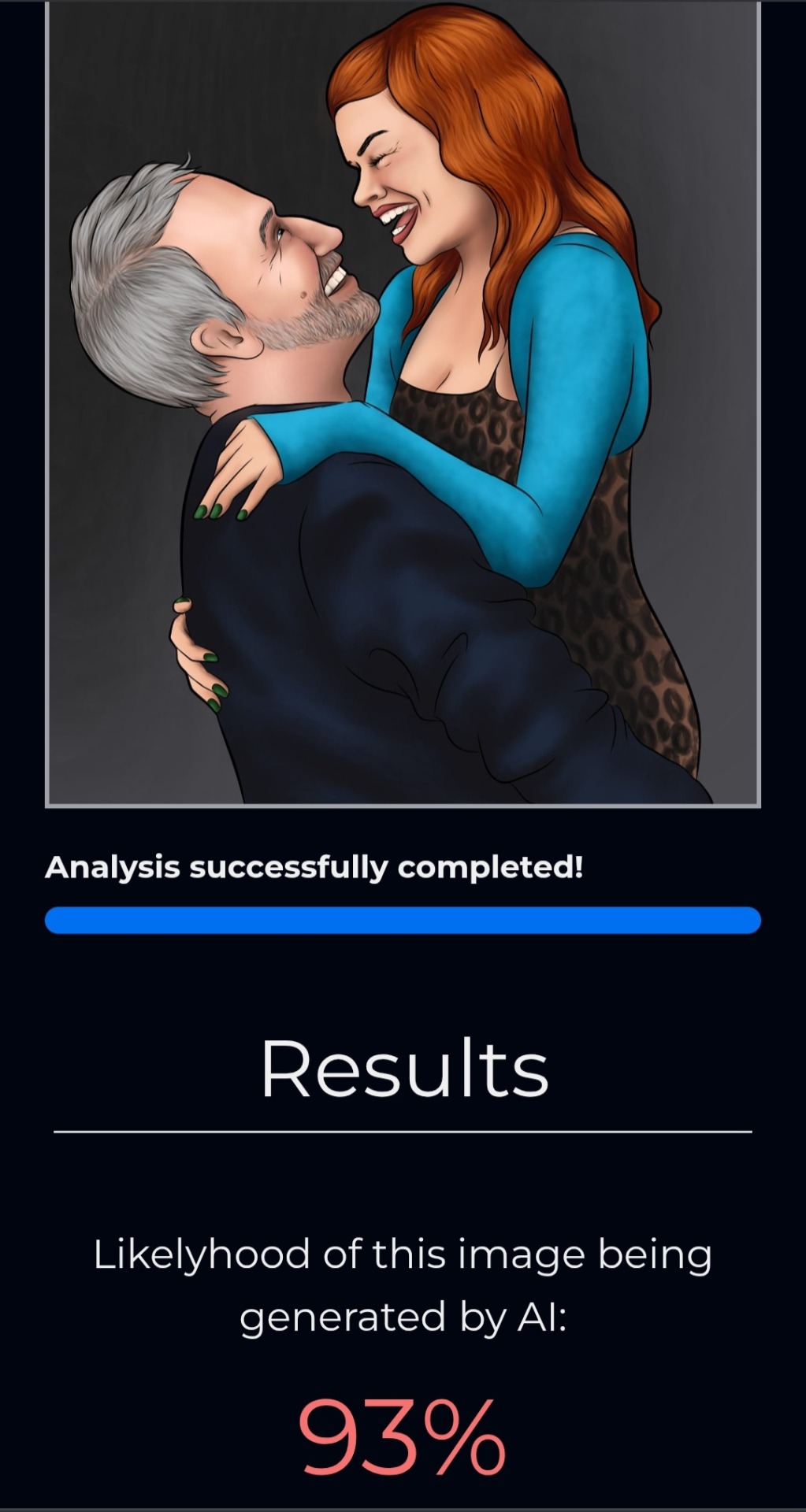


We've gotta talk about the fact that detection of NSFW content and AI Gen content is being left to AI. I checked a dozen of my own artworks on an AI detection site and it told me 80% of them were likely AI. It also predicted several NSFW images among my entirely SFW content.
AI is literally trained off real stolen art, and its goal is to get better and better at faking it. It's getting to the point where humans are second guessing every time we do see real art, and and a horrible feeling that is. The irony of the fact that they're leaving the job of AI identification to AI is baffling. These so called detectors and automated systems are wildly inconsistent and inaccurate, we need to stop relying on AI for literally everything.
14 notes
·
View notes
Text
Hello foraging friends! Don’t know how far this has gotten yet but there is a new and potentially DEADLY scam going on where AI generated foraging/botany/identification books are being sold on sites like Amazon, with mislabeled and misidentified species, including toxic fungi. Much of the content is utter nonsense, filled with grainy black and white photos, and authored by people who do not exist. Afaik the scam was first identified by a friend of mine on twt @heyMAKWA and info has only just started to spread.
Please check the sources of any foraging guide books you are considering purchasing and using! Never consume plants or fungi that you are not 100% sure are safe to eat!
Reddit posts about the issue
https://www.reddit.com/r/foraging/comments/15ur88d/please_please_be_careful/
https://www.reddit.com/r/foraging/comments/15p9b7t/ai_generated_foraging_books/
208 notes
·
View notes
Text

We've got some new cover art and as someone who works in digital media and deals with AI content on daily basis this new cover for Troy Saga set off an alarm in my brain. Naturally I sank into an analyzing spiral, because that's just how my brain works.
"Looks like an AI art with repaints on top" I thought to myself, but to be sure I've checked it with different AI recognizing software (remember kids, if you use AI to generate your art, other AI can reverse engineer the process and identify it!). But so can a human eye most of the time. Pay attention to the combination of these identificators:
- weird blur
- different lines of horizon in one image
- bonkers anatomy/construction errors
- high contrast
- a lot of nonsense happening in the background
The results of AI checkup on the new Troy cover art were mixed


"Okay, let's check out the original Troy Saga cover, I like this one"

Yep, it has no out of place blur, the wooden horse's anatomy doesn't weird me out, the backgrounds look nice, deliberately painted with attention and care, I can make sense of the individual strokes. Good to know that my eyes are still good for something.
"Just to be sure, let's check out the Cyclop's Saga"
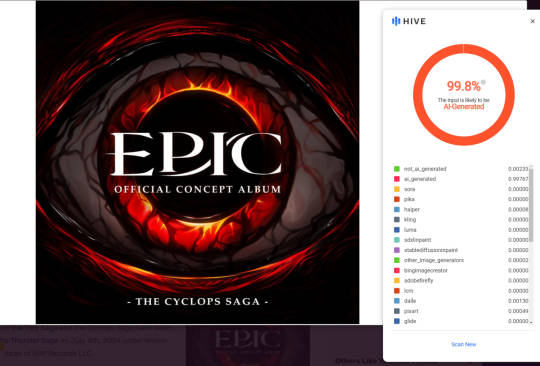

Okay, now it's proper weird. Maybe the Hive is off caliber? Wait five minutes, let me make a quick AI Thunder Saga cover art.
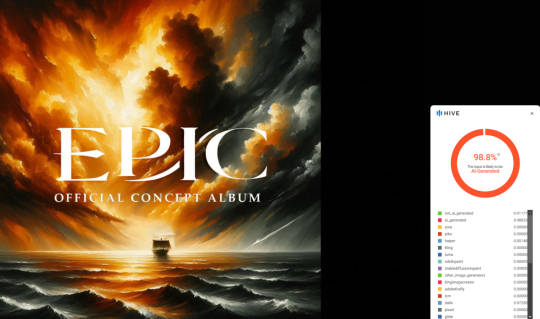
Nope, still works. What about other covers?

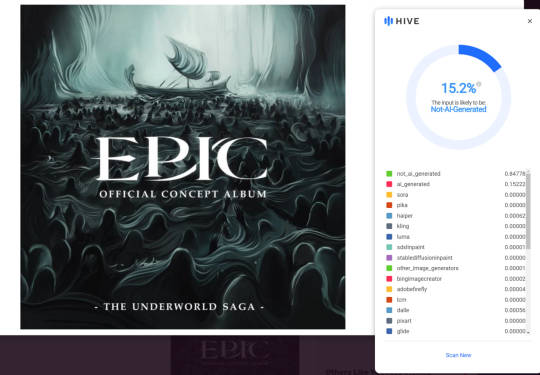
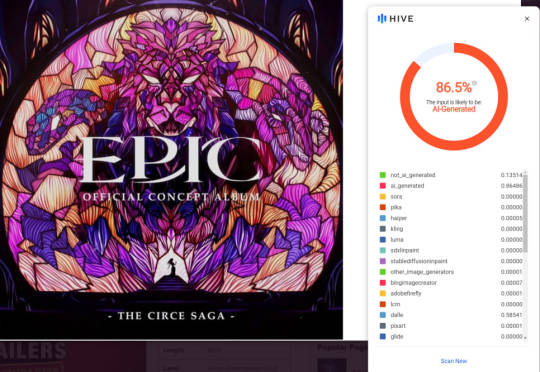
Fascinating! To be honest Circe Saga cover art doesn't look like Ai to me (all three animals are drawn with nice proportions and the lion is probably drawn with the help of Symmetry tool in Procreate, AI is surprisingly shitty at doing perfect symmetry).
Maybe it's the style of the artist that's confusing to the AI detector? Zwist seems to be particularly fond of whirlwind designs in all of her artwork (bad AI art often does weird stripes and whirlwinds, especially when you're trying to generate something which doesn't have a lot of references for it in the dataset that AI is trained on). Let's run Hive on her original artwork with a lot of whirlwinds and a wonky tree.

...okay. Now that is weird.
Look, I'm not saying that Zwist is a bad artist or something, using Ai isn't against the law and she clearly can paint better than I do. She is talented, go show love to her original artworks that are not Epic related. Hell, I can't even prove with 100% certainty that AI was used at all. Just because I don't like the new Troy cover art doesn't mean you shouldn't enjoy it too.
But the whole situation is fascinating to me. A lot of people on insta ask if the new Troy cover is AI, only to be shut down by fans who scream "no, that's just her artsyle and X confirmed that it's not AI, you are just haters".
YOU ARE NOW IN THE UPDATED PART OF THE POST
Special thanks to the people who shared the link to the new Troy Saga cover art speedpaint for erasing my doubts and providing a respectful conversation in the comments.
Watched through the speedpaint a few times, trying to figure why the end image became unsettling enough for a lot of people (myself included) to assume it's AI.
My guess is that Zwist has developed for herself an intricate decorative style, but isn't very familiar with so called 'academic' art.
Why do I think that? Well, I wanted to see how artists of the past depicted the wooden horse, and do you know what image you see when you type up 'Trojan horse' into Google? That's right, it's the giant prop from the movie Troy (2004). And you know, no shame here, using references to draw something you've never seen before is good, I'm just shocked I didn't recognize this design sooner it's very cool. What I really like about it is that it really looks like it's been made rather fast from the scraps of the broken down ships and yet it still resembles an actual horse. Look at the cute pointy ears! Look at the mouth of it! This gorgeous posture!

What's even better, it still exists somewhere in Turkey (well maybe not the actual prop, but the full size replica of it), so there's a ton of photos from different points of view. My best guess is that Zweist used this one as a reference for the new Troy Saga cover:

And here's a problem - this is a very complex structure to draw. Not only that, but Zweist also uses two light sources - moonlight from above and the light of the fire below, which means that we have two different sets of shadows emerging from these light sources.
Unlike all other covers that are very decorative in nature, this one is attempted to be very realistic, almost cinematic in its use of lighting. With all that extra complication it's easy to set yourself up for failure and get too much in the details while losing the larger shapes.
Unfortunately in her simplification of the original reference Zweist completely neglects all the intricate shapes and planes that make up the wooden horse. She forgets that wood cannot bend in circles like that, or that unpolished wood is a low-reflective surface (which means that even the lightest spot lit up by the firelight will be darker than the light on the sand/marble/metal coming from the same light source). It seems like she doesn't analyze the shape of it at all, so we lose the majestic posture and the shape of the horse head.
Just for the fun of it I used 1,5 hours of my time to photobash the reference photo into the original Zweist background. It's very rough (I literally painted everything using nothing but a standard Photoshop round brush and a computer mouse), but I think it gets my point across.

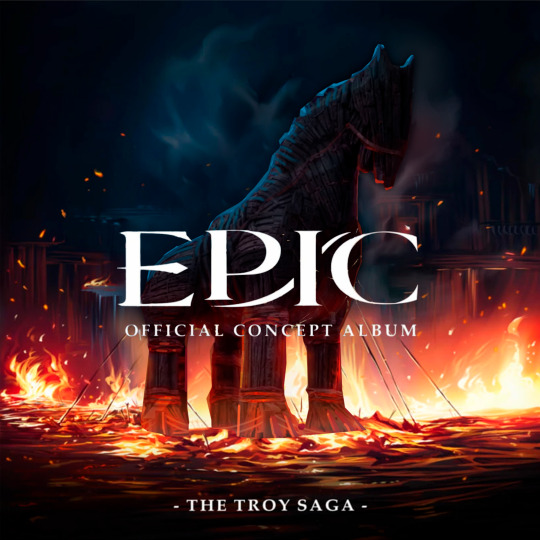
I'm too tired to redo the background and this post is already ridiculously long. But I think that it suffers from the same problems - lack of research and care. Those are just some random shapes taking up space. I get that it's supposedly a burning Troy we see around, but does it look like anything to you? I mean really? Again, it's just a shapeless mess. And all of that could be avoided with a bit of extra research and analysis. There's more to the ancient ruins that the same set of columns over and over.


So, what is can we learn from it? What is the conclusion?
Zwist is a talented young artist, but painting "realistically" isn't her strongest suit. You may like her style, or you may not, but I think there is a difference between "doing it your way" and "trying to succeed and failing". She may try to learn from this situation in two ways: 1) work around her stronger sides making the next covers with simpler designs and less intricate lighting or 2) practice the more realistic style and get better at it.
I don't know the exact reasons why the AI recognizing software flagged some of her work as AI generated. But I think that if it's not just your audience who starts to wonder if you used AI, but you somehow manage to confuse the very program that detects AI, then you've got a problem with your art.
If we want to beat AI companies in their game and stay relevant as professional artists we can no longer produce mindless art. We can no longer afford to produce sloppy work. As sad as it is, within next 10 years there is going to be a large shift in understanding and producing art as we know it. If the art we create can be easily replicated by AI or will look like it's been made with AI, then no one would bother to commission art from you. We have to adapt, to find new ways of exploring our creativity, perhaps even to create a new visual language of expressing ourselves.
In the end of a day human art always beats AI art. You know why? Because AI is not really Artificial Intelligence. It's just a very complex algorithm that is good at recognizing patterns. That's all it is. It doesn't have a conscience, it has no context for the human experience, it cannot think, and most importantly - it cannot invent.
So I want to end this post on the hopeful note - the art will survive. The artists will survive. And if we can learn anything from this situation is that kindness and open dialog is the vest way to deal with confusion. Once again I want to thank everyone who was kind enough to comment on and engage with this post. It grew out of love for something that is deep and personal to me (Epic) to a larger discussion of the changes in the world of visual art (something I love and care for even more). Hope this update spawns more nuanced and respectful discussion on the topic!
#epic#epic the musical#I hate this timeline (but slightly less now)#troy saga#thank everyone for sending a link to the speedpaint#read the post if you want to watch me gradually lose my sanity over unimportant stuff I guess#ai art
35 notes
·
View notes
Text
During the November round of AI integrations, SoundCloud said in a press release it would double down on treating musicians better, per their "commitment to responsible, innovative and ethical use of creative AI tools" by partnering with services designed to "provide all of our existing and new AI partners access to content identification solutions," which SoundCloud said would ensure "rights holders receive proper credit and compensation."
Boy, that sure sounds like a lot of bullshit right there.
Can't remember if this is old news around here or not, figured it would be better to share just in case.
8 notes
·
View notes
Text
Recently, former president and convicted felon Donald Trump posted a series of photos that appeared to show fans of pop star Taylor Swift supporting his bid for the US presidency. The pictures looked AI-generated, and WIRED was able to confirm they probably were by running them through the nonprofit True Media’s detection tool to confirm that they showed “substantial evidence of manipulation.”
Things aren’t always that easy. The use of generative AI, including for political purposes, has become increasingly common, and WIRED has been tracking its use in elections around the world. But in much of the world outside the US and parts of Europe, detecting AI-generated content is difficult because of biases in the training of systems, leaving journalists and researchers with few resources to address the deluge of disinformation headed their way.
Detecting media generated or manipulated using AI is still a burgeoning field, a response to the sudden explosion of generative AI companies. (AI startups pulled in over $21 billion in investment in 2023 alone.) “There's a lot more easily accessible tools and tech available that actually allows someone to create synthetic media than the ones that are available to actually detect it,” says Sabhanaz Rashid Diya, founder of the Tech Global Institute, a think tank focused on tech policy in the Global South.
Most tools currently on the market can only offer between an 85 and 90 percent confidence rate when it comes to determining whether something was made with AI, according to Sam Gregory, program director of the nonprofit Witness, which helps people use technology to support human rights. But when dealing with content from someplace like Bangladesh or Senegal, where subjects aren’t white or they aren’t speaking English, that confidence level plummets. “As tools were developed, they were prioritized for particular markets,” says Gregory. In the data used to train the models, “they prioritized English language—US-accented English—or faces predominant in the Western world.”
This means that AI models were mostly trained on data from and for Western markets, and therefore can’t really recognize anything that falls outside of those parameters. In some cases that’s because companies were training models using the data that was most easily available on the internet, where English is by far the dominant language. “Most of our data, actually, from [Africa] is in hard copy,” says Richard Ngamita, founder of Thraets, a nonprofit civic tech organization focused on digital threats in Africa and other parts of the Global South. This means that unless that data is digitized, AI models can’t be trained on it.
Without the vast amounts of data needed to train AI models well enough to accurately detect AI-generated or AI-manipulated content, models will often return false positives, flagging real content as AI generated, or false negatives, identifying AI-generated content as real. “If you use any of the off the shelf tools that are for detecting AI-generated text, they tend to detect English that's written by non-native English speakers, and assume that non-native English speaker writing is actually AI,” says Diya. “There’s a lot of false positives because they weren’t trained on certain data.”
But it’s not just that models can’t recognize accents, languages, syntax, or faces less common in Western countries. “A lot of the initial deepfake detection tools were trained on high quality media,” says Gregory. But in much of the world, including Africa, cheap Chinese smartphone brands that offer stripped-down features dominate the market. The photos and videos that these phones are able to produce are much lower quality, further confusing detection models, says Ngamita.
Gregory says that some models are so sensitive that even background noise in a piece of audio, or compressing a video for social media, can result in a false positive or negative. “But those are exactly the circumstances you encounter in the real world, rough and tumble detection,” he says. The free, public-facing tools that most journalists, fact checkers, and civil society members are likely to have access to are also “the ones that are extremely inaccurate, in terms of dealing both with the inequity of who is represented in the training data and of the challenges of dealing with this lower quality material.”
Generative AI is not the only way to create manipulated media. So-called cheapfakes, or media manipulated by adding misleading labels or simply slowing down or editing audio and video, are also very common in the Global South, but can be mistakenly flagged as AI-manipulated by faulty models or untrained researchers.
Diya worries that groups using tools that are more likely to flag content from outside the US and Europe as AI generated could have serious repercussions on a policy level, encouraging legislators to crack down on imaginary problems. “There's a huge risk in terms of inflating those kinds of numbers,” she says. And developing new tools is hardly a matter of pressing a button.
Just like every other form of AI, building, testing, and running a detection model requires access to energy and data centers that are simply not available in much of the world. “If you talk about AI and local solutions here, it's almost impossible without the compute side of things for us to even run any of our models that we are thinking about coming up with,” says Ngamita, who is based in Ghana. Without local alternatives, researchers like Ngamita are left with few options: pay for access to an off the shelf tool like the one offered by Reality Defender, the costs of which can be prohibitive; use inaccurate free tools; or try to get access through an academic institution.
For now, Ngamita says that his team has had to partner with a European university where they can send pieces of content for verification. Ngamita’s team has been compiling a dataset of possible deepfake instances from across the continent, which he says is valuable for academics and researchers who are trying to diversify their models’ datasets.
But sending data to someone else also has its drawbacks. “The lag time is quite significant,” says Diya. “It takes at least a few weeks by the time someone can confidently say that this is AI generated, and by that time, that content, the damage has already been done.”
Gregory says that Witness, which runs its own rapid response detection program, receives a “huge number” of cases. “It’s already challenging to handle those in the time frame that frontline journalists need, and at the volume they’re starting to encounter,” he says.
But Diya says that focusing so much on detection might divert funding and support away from organizations and institutions that make for a more resilient information ecosystem overall. Instead, she says, funding needs to go towards news outlets and civil society organizations that can engender a sense of public trust. “I don't think that's where the money is going,” she says. “I think it is going more into detection.”
8 notes
·
View notes
Text

Real-time anomaly detection at the edge. Our model’s architecture is designed for rapid identification and filtering of inappropriate content, maintaining a safe and compliant user experience. #FALCONS.AI #FALCONS AI #FALCONSAI
2 notes
·
View notes
Text
Cloud Squatting: Understanding and Mitigating a Modern Cyber Threat

Cloud computing is central to both business and personal data storage. A critical and emerging threat is cloud squatting.This phenomenon, a digital variant of the notorious domain squatting, involves the unauthorized occupation of cloud resources. It poses significant risks, making it a crucial concern for everyone, from casual cloud users to IT professionals and business owners.
Understanding cloud squatting
Cloud squatting is the practice of occupying cloud resources, such as storage accounts, domain names, or service identifiers, often for exploitative purposes. This could range from reselling these resources for profit to hosting harmful content or phishing scams. Cloud squatting not only mirrors traditional domain squatting but also extends to trafficking cloud resources like cloud computing instances or web applications, typically for malicious intentions.
The risks involved
Cloud squatting presents various risks:
Data theft: Unauthorized instances can store or transmit stolen data.
Security breaches: They can act as platforms for attacks on other systems.
Reputation damage: Companies suffer if their services are impersonated.
Legal and financial repercussions: In cases of brand damage and loss of customer trust.
For example, an attacker might use a service resembling a legitimate one, deceiving users into sharing sensitive information, leading to data breaches and tarnished reputations.
Mitigation strategies
Effective mitigation of cloud squatting involves a multi-faceted approach:
Proactive registration: Secure variations of your business’s cloud resource names.
Regular audits: Ensure all cloud services are legitimate.
Monitoring and alert systems: Detect unauthorized or misleading registrations.
Employee training: Educate about risks and the identification of suspicious services.
Legal protections: Utilize trademarks and enforce anti-squatting policies.
Security tools and best practices: Use AI-driven solutions and update security measures regularly.
Stakeholder education: Inform teams and customers about these risks.
Rapid response plan: Have a plan to address incidents swiftly.
Collaboration with cloud providers: Utilize their anti-squatting policies.
Reserved IP addresses: Transfer owned IPs to the cloud and manage records.
Policy enforcement: Prevent hard coding of IP addresses and use reserved IPv6 addresses.
The future of cloud security
As cloud technologies evolve, so do the tactics of cybercriminals. This makes proactive security measures and constant vigilance essential. Emerging technologies, like AI-driven security solutions, will play a crucial role in combating these threats.
Cloud squatting is a modern cyber threat that demands awareness, understanding, and proactive action. Implementing robust security strategies and staying informed about the latest trends in cloud security can significantly protect valuable digital assets. By addressing the risks and employing comprehensive mitigation strategies, individuals and businesses can safeguard their presence and integrity in the cloud.
Centizen, your trusted partner in cloud consulting and staffing provides unparalleled expertise and solutions to guard against threats like cloud squatting, ensuring the security and efficiency of your digital infrastructure.
#CloudSquatting#CyberSecurity#CloudSecurity#DataProtection#DigitalThreats#CloudComputing#InfoSec#AIinSecurity
2 notes
·
View notes
Text
I put my YouTube video into an AI summarizer
I made a YouTube channel recently where I plan to upload content surrounding the realm of peaceful living and exploring my own interests in an attempt to inspire others to explore their own interests. My most recent video was slightly related to this concept, but I feel like it was a good starting point for my channel.
Summary
• 🌧️ Gen Z and Emotional Exhaustion
The speaker highlights how Gen Z is deeply emotionally drained—not from physical labor, but from navigating identity in a hyperconnected digital world. The root cause is social conditioning to seek shortcuts, leading to superficial self-identification via social media trends.
• 🧩 Identity vs Self Understanding
A sharp distinction is made between identity (externally defined labels) and self-understanding (internal spiritual awareness). Many young people jump to form identities without first deeply understanding themselves.
• ⚠️ The Pitfall of Rebellion
Many people—especially youth—choose identities as an act of rebellion rather than reflection. This performative self-expression, while sometimes useful, often stems from societal pressure rather than authentic discovery.
• 📱 Social Media’s Influence
Platforms like TikTok accelerate identity-shifting, promoting aesthetics and trends (e.g., “clean girl”, “mafia wife”) as identities. These fleeting labels encourage users to conform rather than explore themselves.
• 🛠️ Tools Misused: MBTI and Astrology
The video critiques how tools like MBTI and astrology are misused as definitive identity markers. Instead, they should be analytical frameworks—not boxes people force themselves into.
• 🧠 Critical Thinking and Emotional Detachment
Self-discovery demands rigorous critical thinking. The speaker argues for separating emotion from analysis to truly question and understand one’s beliefs, desires, and reactions without bias.
• 🧏 Listening and Growth
Respectful discourse is emphasized. Even criticism, if logical and well-meant, can fuel self-growth. The video calls for humility, openness, and receptiveness when engaging with differing perspectives.
• ��� Feedback from Others
While most self-work is internal, feedback from others plays a vital 20% role in filling blind spots. Navigating the fine line between being too self-centered and too easily influenced is essential.
• 📦 The Danger of Over-Identification
Adopting identity prematurely without introspection can crush individuality. People often confuse rebelling against societal norms with genuine self-expression, falling into new conformist molds.
• 🔄 Lifelong Journey of Understanding
Self-understanding is not a two-year crash course but a lifelong commitment. Identity is presented as the final project—formed after intense self-study—not a starting point.
Have a lovely day!
~ aerie
2 notes
·
View notes
Text





Here's a breakdown of the features presented in the schematics for the PlayStation 7 controller, designed to showcase both technical and ergonomic innovations:
8K HD LCD Mirror Screen
Feature: Center display with 8K resolution in a Silicium Black mirror finish.
Purpose: Offers high-definition visuals directly on the controller, enabling in-game stats, real-time updates, and mirrored content from the main console.
AI Self-Learning Capabilities
Feature: Embedded AI that adapts to user preferences and gameplay styles.
Purpose: Optimizes controller response, remaps buttons based on usage patterns, and provides personalized feedback.
Compact, Ergonomic Design
Feature: Approximately one-quarter inch smaller than standard controllers.
Purpose: Offers enhanced portability, making it more pocket-sized, while maintaining ergonomic comfort for longer gameplay.
Connectivity Ports
HDMI: Allows direct connection to displays or peripherals.
USB: Enables device charging, wired connectivity to the console, and data transfer.
Charging Module: Specialized port for rapid recharging of the controller.
Purpose: Ensures multi-functional connectivity for various gaming setups.
Bluetooth, WiFi, and FiWi Capabilities
Feature: Enhanced wireless capabilities, including Bluetooth and WiFi for direct connectivity, and FiWi sensing.
Purpose: Enables seamless, lag-free connections to the PlayStation 7 console and other devices, along with FiWi for future wireless advancements.
Internal Modular Layout
Feature: Internally organized layout with modular components for AI chip, connectivity modules, and display.
Purpose: Simplifies upgrades, repairs, and component replacements, enhancing longevity and customization.
Enhanced Battery System
Feature: High-capacity battery designed for extended play sessions.
Purpose: Supports advanced features and power-intensive display without compromising battery life.
Dual-Tone Color Variants
Colors: Available in Lo Rider DyeCast Yellow, Black, Silver Chrome, Forest Green, and Azure, plus two-tone combinations.
Purpose: Offers aesthetic customization, appealing to a wide audience with multiple design options.
Identification Details
QR Code: Unique QR codes for easy registration and product information access.
Serial Numbers and Model Numbers: Ensures authenticity and facilitates tracking for warranty, support, and inventory.
Purpose: Helps with identification and authentication for warranty, inventory, and support purposes.
Enhanced Sensory Capabilities
Feature: Equipped with advanced sensors to detect and respond to motion, orientation, and grip pressure.
Purpose: Improves gameplay experience by adding a responsive, immersive control experience.
These features collectively position the PlayStation 7 controller as a cutting-edge, user-focused gaming device with both aesthetic appeal and functional versatility, ready for patent submission. Let me know if further elaboration is needed!


The PlayStation 7 controller can enable a consoless gaming experience by leveraging its innovative hardware features, which allow it to function independently from the console in a variety of ways:
Integrated 8K HD LCD Mirror Screen
Description: The high-resolution 8K LCD screen built into the controller displays full gameplay visuals without needing a TV or separate monitor.
Functionality: This screen allows users to play games directly on the controller, effectively transforming it into a standalone gaming device when paired with online gaming capabilities.
AI Self-Learning System
Description: The controller’s AI learns player preferences, adapts control settings, and customizes responses based on gameplay style.
Functionality: This allows for quick, user-specific adjustments without external inputs, creating a more personal and tailored gaming experience even without a console.
Embedded Processing and Networking Capabilities
Description: Equipped with processors for basic game streaming and internet connectivity via WiFi, Bluetooth, and FiWi.
Functionality: The controller can stream games from the cloud or connect to local servers. It essentially functions as a portable gaming device by accessing games directly from cloud platforms.
Modular Connectivity Ports (HDMI and USB)
Description: With HDMI, USB, and charging ports, the controller supports multi-functional connectivity.
Functionality: It can connect to external monitors, TVs, or displays, allowing players to shift seamlessly between small-screen (on-controller) and larger-screen gaming without needing a console.
Advanced Bluetooth and FiWi for Peripheral Pairing
Description: The controller’s Bluetooth and FiWi capabilities enable pairing with additional devices like headphones, VR headsets, or external gamepads.
Functionality: This gives players access to an entire peripheral ecosystem without a console. It supports multiplayer and VR applications by connecting directly to other devices.
Cloud-Based Gaming Infrastructure
Description: The controller is designed to leverage cloud gaming services, with an interface that allows game downloads, storage management, and updates.
Functionality: Users can access and play titles stored on cloud servers directly from the controller, offering console-like gameplay with portability.
Standalone Battery and Power Management System
Description: High-capacity battery allows for extended gameplay time.
Functionality: Without dependence on an external power source, the controller can function as a self-sufficient gaming device, giving players freedom to game from anywhere.
Specialized Sensor Array for Immersive Gameplay
Description: Sensors for motion, orientation, and grip provide feedback and allow for intuitive controls.
Functionality: The sensors support games that require movement and responsiveness without additional hardware, further enhancing the controller’s ability to stand alone as a gaming platform.
Through these innovations, the PlayStation 7 controller essentially acts as a mini console. Its blend of display technology, AI, processing power, connectivity, and cloud gaming access brings a full gaming experience into a single compact device.
#Playatation7#CandyPaintJobDyeCastLoRiderYellow Controller#Yellow controller#special Edition#LoRiderYellow#PaintJobYellow#Playstation7Controller#Special edition#Exclusive#DigitalConsole#consolessGaming
4 notes
·
View notes
Text
Revolutionizing Enterprises: CXO’s GenAI Transformation

1. Unlocking AI’s Potential: A Strategic Overview
AI adoption, embraced by 70% of executives, promises enhanced customer experiences despite challenges. Understanding and integrating AI into business operations is essential. Explore our guide for actionable insights, ensuring businesses not only survive but thrive in the AI-driven era.
Learn more about Artificial Intelligence impact in 2025
AI Reshaping Decision-Making in 2025
Generative AI, like GPT, simplifies business processes. It transforms decision-making with its user-friendly interfaces, self-learning capabilities, and efficient sorting.
Furthermore, it’s a budget-friendly solution with no training fees, making it accessible for businesses of various sizes.
Our guide aims to offer practical insights for responsibly adopting this transformative technology. Following our roadmap allows businesses to navigate the Generative AI landscape, ensuring success in the constantly changing digital environment.
To stay informed and up to date with the latest trends, join our webinars featuring industry experts from organizations like Microsoft, Shell, and more.
C-Suite Roles Transformed by AI

Strategic AI Adoption Tips for Leaders
To successfully adopt AI, prioritize it for strategic goals, use tailored features, and embrace multilingual capabilities. Ensure secure deployment for data integrity. Offices that adopt AI enjoy streamlined processes, ongoing innovation, and secure frameworks.
2. Transforming C-Suite Roles with AI
Empowering CIOs: Innovating IT with AI
In enterprise IT, AI, particularly models like GPT, empowers CIOs to break traditional boundaries and improve operations through groundbreaking innovations.
Use Cases:
· Smart IT Helpdesk Support: AI ensures 24x7 support with human-like conversations, reducing user effort and cost.
· Smart Search: AI transforms data management, improving user engagement with easy-to-use search capabilities.
· Next-Gen Customer Support: AI automates email-based queries, crafting personalized responses for enhanced customer experiences.
To stay informed and up to date with the latest trends, join our webinars featuring industry experts from organizations like Microsoft, Shell, and more.
Implementation Tips:
· Prioritize AI for strategic goals.
· Personalized and multilingual capabilities.
· Ensure secure deployment for data integrity.
· Offices embracing AI experience streamlined helpdesks, continuous innovation, and secure frameworks.
Empowering HR with AI: From Administration to Leadership

Use Cases:
· AI-powered Talent Acquisition: AI streamlines global recruitment, automating candidate screening and optimizing interview scheduling.
· Efficient Employee Onboarding: AI redefines onboarding by using chatbots to create personalized experiences and promote communication across departments.
· Personalized Employee Engagement: AI’s learning capabilities drive adaptive engagement activities, ensuring timely interventions and integrating feedback loops.
· Data-Driven Learning and Development: AI changes learning through advanced knowledge mining, personalized modules, and interactive interfaces.
Implementation Tips:
· Align AI integration with strategic HR goals.
· Leverage AI’s personalization and multilingual features.
· Uphold data integrity and fortify security during deployment.
· Offices leveraging AI experience streamlined recruitment, efficient onboarding, personalized engagement, and reimagined L&D.
Also, read more about How GPT-powered Chatbots Can Help HR Leaders Drive Engagement and Retention
AI-Powered Marketing: A CMO’s Secret Weapon

Use Cases:
· AI-Powered Brand Engagement Solutions: AI revolutionizes brand engagement with personalized content, human-like communication, and timely identification of upsell opportunities.
· Smartly allocate ad spending: AI enables CMOs to allocate budgets wisely by analyzing real-time market trends predictively.
Implementation Tips:
· Prioritize AI Integration aligned with core marketing goals.
· Leverage Multilingual Features for global brand reach.
· Strategize Deployment with a focus on data integrity and customer privacy.
· Offices with AI experience tailored brand engagement, proactive ad spend decisions, and seamless multilingual marketing.
Explore the Power of Generative AI for enhancing CX — Marketing and Customer support/ Engagement
AI: The COO’s Catalyst for Operational Agility and Efficiency
In the realm of Operational efficiency, Chief Operating Officers (COOs) orchestrate processes to optimize resources.
Use Cases:
· Simplifying the supply chain: Artificial Intelligence (AI) provides a high-level perspective, facilitating proactive demand forecasting and prompt corrective actions for effective supply chains.
· Enhancing Operational Communication: AI-powered chatbots ensure role-specific information flow, facilitating real-time feedback and swift issue resolution.
· Driving Operational Cost Optimization: AI analyzes data for cost leakage points, recommends resource redistribution, and encourages real-time cost insights.
To stay informed and up to date with the latest trends, join our webinars featuring industry experts from organizations like Microsoft, Shell, and more.
Implementation Tips:
· Justify Integration Effort with improved operational KPIs.
· Leverage Iterative Learning for continuous process refinement.
· Prioritize Data Security, safeguarding organizational assets.
· Offices with AI experience data-driven supply insights, intelligent communication, and dynamic cost optimization.
· In the dynamic field of data management, Chief Data Officers (CDOs) use AI, including GPT and other generative AI models, as strong supporters to decode large datasets effectively.
Use Cases:
· Enhancing Data Intelligence: AI’s advanced algorithms mine data, providing insights that shape business strategies through predictive modeling and intelligent summarizing.
· Managing Unstructured Data: AI’s NLP features efficiently process and convert unstructured data into organized, clear formats, enhancing data processing efficiency.
· Enhancing Data Governance: AI simplifies data management by automating organization, ensuring compliance with regulatory policies, real-time breach detection, and maintaining data standards.
Implementation Tips:
· Start with a clear data strategy aligning AI’s abilities with major data challenges.
· Prioritize data protection in AI adoption for utility and security.
· Invest in continuous training, refining AI models for better understanding of organizational data.
· Offices with AI experience automated, intelligent data insights, streamlined data, and proactive, AI-assisted data governance.
3. AI’s Impact: Boosting Enterprise Efficiency
Discover how advanced AI, including Azure OpenAI’s GPT, is reshaping enterprise operations. Explore real-world use cases across departments, showcasing the profound impact of Generative AI on organizational efficiency.
AI Integration Across Departments
SharePoint Search Integration

Structured Data Insights & Summarization
AI enables the effortless transformation of structured data into actionable intelligence. This module analyzes tables and databases, extracting meaningful insights presented in user-friendly natural language summaries, empowering teams for informed decision-making.
R&D Assistant
In Research and Development, AI acts as a dedicated assistant, leveraging internal and external data sources for comprehensive reports and analysis.
Customer/Consumer Support
Elevate customer support with an AI-powered chatbot that delivers personalized and context-aware responses. By training the model with customer support data, this solution ensures accuracy and seamless integration with existing systems.
HR Chatbot
AI becomes an invaluable virtual assistant in HR, guiding employees through common queries with personalized responses. From leave requests to company policies, this intelligent chatbot ensures a seamless and efficient employee experience.
IT Chatbot
Revolutionize IT support by using an AI-powered chatbot. The chatbot can troubleshoot common issues, give step-by-step instructions, and escalate complex cases. Enhance user experience and streamline technical support with this essential tool.
To stay informed and up to date with the latest trends, join our webinars featuring industry experts from organizations like Microsoft, Shell, and more.
Document Comparison/RFP Validation
AI streamlines procurement and HR processes by comparing documents. Quickly analyze text documents for similarities, differences, and changes, ensuring accuracy in document validation and specifications.
Procurement Assistant
Automate and streamline the procurement process with an AI-powered assistant. Generate purchase orders, request for quotations, and vendor evaluations based on predefined templates and user inputs, ensuring efficiency and accuracy.
Search Integration with SAP JAM/ServiceNow KB/Salesforce KB
Bridge the knowledge gap by integrating AI with ERP and ITSM systems. Enable interactive conversations beyond search results, enhancing user understanding and engagement with content.
Knowledge Management Solution
Empower your workforce with a Knowledge Management Solution seamlessly merging AI with Azure Cognitive Search. Unlock information from diverse sources, fostering a culture of knowledge-sharing and collaboration.
Integrate innovative AI use cases into your strategy for streamlined processes and enhanced user experiences.
4. Unlocking AI’s Power with Acuvate: A Comprehensive Guide
As businesses embrace AI’s transformative potential, Generative Pre-trained Transformers (GPT) take center stage, enhancing productivity. Our guide delves into AI FAQs, ensuring data security and adaptability for enterprise needs.
To stay informed and up to date with the latest trends, join our webinars featuring industry experts from organizations like Microsoft, Shell, and more.
Acuvate Advantage
Experience the Org Brain GPT framework, combining analytics and enterprise security. Acuvate’s expertise, spanning 16 years, ensures customized AI solutions for streamlined processes.
Explore our AI trends guide to boost your organization’s capabilities. Request a demo or insight into Acuvate’s transformative AI solutions for enhanced performance.
Also, read our other blogs on the AI revolution on Medium
9 Must-Watch Webinars of 2025 for Tech Enthusiasts | Medium
- AI-Driven Transformation: A CXO's Guide to Generative AI Success | Medium
GPT Revolution in AI - A Strategic Guide for CXO | Medium
Emerging Energy Technologies: Data, AI & Digital Solutions in 2025 | Medium
#hyperautomation#microsoft fabric#tech webinars 2025#ai#artificial intelligence#data integration#data platforms#machine learning
2 notes
·
View notes
Text
SUBMISSION GUIDELINES
SUBMISSION GUIDELINES
THE SERIES
The 4 Pages 16 Bars: A Visual Mixtape trade paperback series is a celebration of where true diversity exists in this industry. It is a living historical document, the gold standard of independent works from creators of color. It is a sampler for potential fans to enjoy our intellectual properties. It is a showcase for existing and upcoming talent and a source guide for those fans to purchase our books.
The first volume dropped in June 2015 with subsequent volumes released in Fall 2015, Winter 2016, Spring 2016 and Fall 2018. We had three very successful Kickstarters for Volumes 6, 7 and 8, which were released in Spring 2021, Summer 2021, and Spring 2022. The ninth volume coincided with the 50th anniversary of Hip Hop in 2023. We’re looking for content that will make up Volume 10 of the longest running anthology series featuring independent works from creators of color.
CRITERIA
This is what we are looking for: EXCERPTS FROM EXISTING COMIC BOOKS, GRAPHIC NOVELS, E-COMICS WEBCOMICS AND COMIC STRIPS
Minimum of four pages (or comic strips) of a property that has been published or will be published within the next six months.
ILLUSTRATION AND/OR FINE ART
Minimum of four images, maximum of eight images for our gallery spotlight sections. Renditions of characters from popular culture (i.e. Marvel, DC, Star Wars, Star Trek, anime or any other licensed properties) WILL NOT BE ACCEPTED.
NO AI-GENERATED IMAGES WILL BE ACCEPTED.
ARTICLES, POEMS OR PROSE
We are looking for articles that speak to the history of creators and/or characters of color in comics. These articles are not advertisements, but more so academic explorations of the sequential art medium and popular culture. Maximum of 1500 words.
We are also looking for short stories, poems or excerpts of speculative fiction. Poem submissions have a maximum limit of five entries. Short stories have a maximum of 2500 words. Excerpts from speculative fiction have a maximum of five pages.
GENRE
We are open to all subgenres of speculative fiction. Superheroes, Sci-Fi, Westerns, Horror, Humor, Fantasy… We like it all! It just has to have soul, flavor and people of color should be the focus either “in front of the camera” (characters and concepts) or “behind the scenes” (creative teams). The works in previous volumes are from creators who are Black, white, Asian, LGBTQ, local and global. Our main concerns are QUALITY and AUTHENTICITY.
We are looking for COMPLETED works. Things that already exist. You shouldn’t have to create new work to be included in this project. We’re looking for creators who have taken destiny in their own hands. What we are looking for is the next level; creators who have unique viewpoints and vision. We are looking for creators who continue to move the needle.
With that said, the anthology is basically PG-13. 4 Pages 16 Bars has been taught in universities and resides in libraries. So no gratuitous nudity, gore, etc. If you are questioning the taste level of your work, chances are it is not appropriate for the anthology.
BUSINESS
All who are selected must have a professional written biography, minimum of 200 words, for inclusion into the anthology.
All who are selected must have a WEBSITE (not just a social media page) for people to view, purchase products and/or procure services.
DEADLINES
COMICS AND ILLUSTRATION: March 15, 2025.
ARTICLES, SHORT STORIES AND PROSE: March 15, 2025.
SUBMISSION REQUIREMENTS
All art must be 300dpi (print resolution)
All art must be sent in either .JPG, .TIF or .PDF formats
All comic book, graphic novel and E-comic submissions MUST BE 6.625” X 10.25” (full-bleed 6.875” X 10.5”)
Comic book, graphic novel and E-comic submissions must be a MINIMUM OF FOUR PAGES AND A COVER IMAGE WITHOUT text (i.e. logos, subtitles, company identification, etc.)
All prose, articles, short stories and poems must be sent in a Word document (.doc, .docx) or shared through Google Drive for document conversion.
If interested, send us samples of your submission through our CONTACT page or our e-mail address [email protected] for consideration. Best of luck!
#rmaalbc
2 notes
·
View notes
Text
The Pentagon Wants to Use AI to Create Deepfake Internet Users
The Department of Defense wants technology so it can fabricate online personas that are indistinguishable from real people.
The United States’ secretive Special Operations Command is looking for companies to help create deepfake internet users so convincing that neither humans nor computers will be able to detect they are fake, according to a procurement document reviewed by The Intercept. The plan, mentioned in a new 76-page wish list by the Department of Defense’s Joint Special Operations Command, or JSOC, outlines advanced technologies desired for country’s most elite, clandestine military efforts. “Special Operations Forces (SOF) are interested in technologies that can generate convincing online personas for use on social media platforms, social networking sites, and other online content,” the entry reads. The document specifies that JSOC wants the ability to create online user profiles that “appear to be a unique individual that is recognizable as human but does not exist in the real world,” with each featuring “multiple expressions” and “Government Identification quality photos.”
[...]
The Pentagon has already been caught using phony social media users to further its interests in recent years. In 2022, Meta and Twitter removed a propaganda network using faked accounts operated by U.S. Central Command, including some with profile pictures generated with methods similar to those outlined by JSOC. A 2024 Reuters investigation revealed a Special Operations Command campaign using fake social media users aimed at undermining foreign confidence in China’s Covid vaccine.
[...]
This more detailed procurement listing shows that the United States pursues the exact same technologies and techniques it condemns in the hands of geopolitical foes. National security officials have long described the state-backed use of deepfakes as an urgent threat — that is, if they are being done by another country.
[...]
The offensive use of this technology by the U.S. would, naturally, spur its proliferation and normalize it as a tool for all governments. “What’s notable about this technology is that it is purely of a deceptive nature,” said Heidy Khlaaf, chief AI scientist at the AI Now Institute. “There are no legitimate use cases besides deception, and it is concerning to see the U.S. military lean into a use of a technology they have themselves warned against. This will only embolden other militaries or adversaries to do the same, leading to a society where it is increasingly difficult to ascertain truth from fiction and muddling the geopolitical sphere.”
4 notes
·
View notes
Text
I'm happy to tell you all that I have adopted a new hobby making bots on janitorai, and am now taking requests for bots from pretty much any fandom because I've adopted a lot of new interests and cannot name every fandom I am in. Requests can be sent here or in my inbox. Luckily for everyone looking for unfiltered bots, Janitorai supports NSFW content!
Feel free to give me your Janitor ai username if you'd like to for credit and bot identification, but you can also choose to make it anonymous.
View my profile here
#moriarty the patriot#bsd#fandom#fantasy#fanfiction#video games#games#gaming#game#Hogwarts#Baldur’s gate 3#Skyrim#oblivion
8 notes
·
View notes